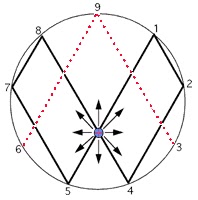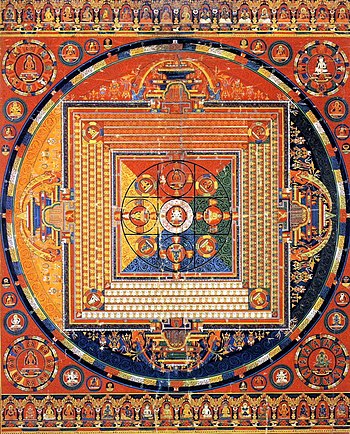According to Walter Russell the cube and sphere are one. Therefore, the 64 squares of the chess board can also be thought of as 64 circles. Nassim Haramein tells us the 64 tetrahedron grid can also be depicted as 64 spheres. (The tetrahedrons are the collapsing or contractive side of the structure of the vacuum, and the spheres around each tetrahedron are the expanding/visible side.) So the cubes enclose the spheres, and the spheres enclose the tetrahedrons. Each shape is intimately connected to the next.
tetrahedron
tetrahedron in a sphere
(Mercedes-Benz logo)
The square playing board divided into 64 smaller squares represents infinity in a limited space. If we imagine each of the smaller squares also divided into 64 we see a theme of infinite division.
The alternating patches of dark and light of the chessboard parallel the alternating patches of dark and light in a star tetrahedron.
a star tetrahedron
viewed from the equator
a star tetrahedron
viewed from 45 degree latitude
4 star tetrahedrons
viewed from the equator
4 star tetrahedrons
viewed from 45 degree latitude
Eight star tetrahedrons make one 64 tetrahedron grid. We also see alternating dark and light in the dual torus which arises from the 64 tetrahedron grid, and in natural rhythms such as the cycles of day and night.
Maṇḍala (मण्डल) is a Sanskrit word that means "circle". In the Buddhist and Hindu religious traditions their sacred art often takes a mandala form. The basic form of most Hindu and Buddhist mandalas is a square with four gates containing a circle with a center point. Each gate is in the shape of a T.[1][2]
These mandalas, concentric diagrams, have spiritual and ritual significance in both Buddhism and Hinduism.[3][4] The term is of Hindu origin and appears in the Rig Veda as the name of the sections of the work, but is also used in other Indian religions, particularly Buddhism. In the Tibetan branch of Vajrayana Buddhism, mandalas have been developed into sandpainting. They are also a key part of anuttarayoga tantra meditation practices.
In various spiritual traditions, mandalas may be employed for focusing attention of aspirants and adepts, as a spiritual teaching tool, for establishing a sacred space, and as an aid to meditation and trance induction. According to the psychologist David Fontana, its symbolic nature can help one "to access progressively deeper levels of the unconscious, ultimately assisting the meditator to experience a mystical sense of oneness with the ultimate unity from which the cosmos in all its manifold forms arises."[5] The psychoanalyst Carl Jung saw the mandala as "a representation of the unconscious self,"[citation needed] and believed his paintings of mandalas enabled him to identify emotional disorders and work towards wholeness in personality.[6]
In common use, mandala has become a generic term for any plan, chart or geometric pattern that represents the cosmos metaphysically or symbolically, a microcosm of the Universe from the human perspective.[citation needed]
The Yantra
A yantra is the yogic equivalent of the Buddhist mandala.
Sri yantra is called the mother of all yantras because all other yantras derive from it.
The Sri Yantra is a configuration of nine interlacing triangles centred around the bindu (the central point of the yantra), drawn by the super imposition of five downward pointing triangles, representing Shakti ; the female principle and four upright triangles, representing Shiva ; the male principle.
Man's spiritual journey from the stage of material existence to ultimate enlightenment is mapped on the Sri Yantra. The spiritual journey is taken as a pilgrimage in which every step is an ascent to the center, a movement beyond one's limited existence, and every level is nearer to the goal.
Each of the circuits of the Sri Yantra, from the outer plane to the bindu (the center), corresponds with one of the stages of the spiritual journey.
The goal of contemplating the Sri Yantra is that the adept can rediscover his primordial sources. The circuits symbolically indicate the sucessive phases in the process of becoming.
http://www.tantra-kundalini.com/sri-yantra.htm
We win the game of chess by depriving our opponent of their sovereignty while maintaining our own. Thus, in this physical reality created by the 64 tetrahedron grid, the struggle between the forces of dark and light is intimately connected to our sovereignty. In fact, it may be that when we awaken to our own sovereignty the need for struggle fades, and we transcend the game of 3D entirely.
In chess there are two classes of people, with the most powerful and important in the back rows (behind the scenes). The more powerful pieces have distinct characteristics (individuality, uniqueness), while the less powerful pieces look like clones. This is a clear indication that our power lies in our individuality and not in our ability to conform.
Of the ruling class, the most important and powerful pieces are closest to the center of the board. Likewise, we are most powerful and influential when we stay close to our own center.
The rooks are circular pieces placed in the four corners of the board (circling the square).
The knights are horses which traditionally represent spirit. The 90 degree turn they make each time they move may be a reference to entering another dimension, as this is what a 90 degree turn symbolized in the ancient Egyptian and Mayan cultures.
If we move our bishops up and out diagonally and continue that straight line off the board in both directions one square, and we do the same with our opponent’s bishops, we trace a square which when combined with the chess board makes an 8 pointed star, which is very important in the Muslim religion and in sacred geometry.
"The
eight-point star
as a symbol marks early human understanding of the intellegent
order that underlies our universe. Today, it carries religous
and mystical associations. Known as the
khatim
(seal of the prophets) in
Islamic cultures." http://www.essaouira.nu/art_symbols.htm
Here is one of Marko Rodin's infinity symbols:
Here is what we get from the bishops:
Extend & mark the 3, 6, 9 coils:
If we took this shape and squished it so it fit inside a circle, we might see it turn into the two infinity symbols on the Phi Matrix, one opposite the other, as shown here:
If the chess board is alluding to our physical reality then it makes sense it would include the symbolism of the dual torus.
Chess is a very left brained game, but there’s an acknowledgement of the right brain/intuition. The king represents the left hemisphere of the brain and the left hemisphere of the earth (the West). Like the left brain, the king moves one step at a time, slowly, analytically, and methodically. By contrast the queen represents the right brain/intuition and the right hemisphere of the earth (the East). As Marko Rodin tells us, the queen can go anywhere. She represents dark matter and the 3, 6, 9 coil of the torus. (Please see Phasing and the Secret of Multiplication - Marko Rodin @ "The Farm" 3 http://www.youtube.com/watch?v=EBWaPP8mNGE&feature=related at minute 9:00.)
She represents our connection to other dimensions and to our intuition.
"The intuitive mind is a sacred gift and the rational mind is a faithful servant.
We have created a society that honors the servant and has forgotten the gift."
~ Albert Einstein
This is why the divine femine has been so suppressed. What happens when the pawns realize they are really royalty and start acting like it? The powers that be do not want us to become as queens (ascend) and break free.
Queen - I Want To Break Free (High Quality)
http://www.youtube.com/watch?v=eM8Ss28zjcE
Is space like a chessboard?
http://newsroom.ucla.edu/portal/ucla/is-space-like-a-chessboard-199015.aspx
For a long time it was thought that the brain was
a mass of tangled wires, but researchers recently found that its fibers are
actually set up like a chess board, crossing at right-angles.http://www.dailymail.co.uk/sciencetech/article-2122681/The-brain-actually-wired-like-chess-board-new-scanner-reveals-stunning-detail.html#ixzz1qnz8auvw
Again, here is one of Marko Rodin's infinity symbols:
Here is what we get from the corporations:
To return to the main blog page, please click: http://logos144.blogspot.com/2011_08_01_archive.html





































